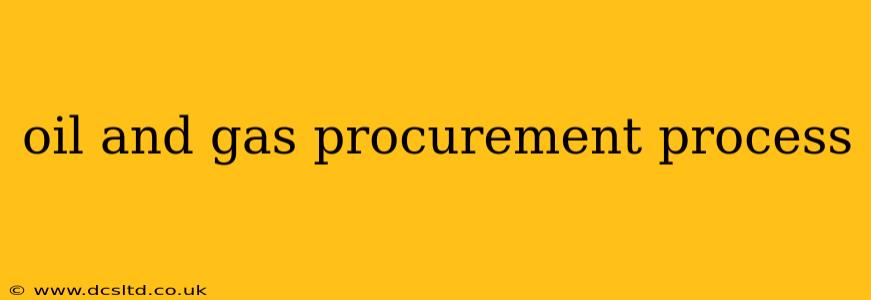The oil and gas industry is a complex and capital-intensive sector, demanding a robust and efficient procurement process. From exploration to production and refining, procuring the right goods and services at the optimal price is crucial for profitability and operational success. This guide will delve into the intricacies of the oil and gas procurement process, addressing key aspects and challenges.
What are the Key Stages in the Oil and Gas Procurement Process?
The oil and gas procurement process typically involves several key stages:
-
Needs Identification and Planning: This initial phase focuses on identifying the specific goods or services needed, understanding their specifications, and estimating quantities. Detailed planning considers project timelines, budget constraints, and potential risks.
-
Supplier Selection and Qualification: A crucial step involves identifying potential suppliers, evaluating their capabilities, and conducting thorough due diligence. This often includes assessing their financial stability, technical expertise, safety records, and compliance with industry regulations. Pre-qualification questionnaires (PQQs) and requests for information (RFIs) are frequently used at this stage.
-
Request for Quotation (RFQ) or Request for Proposal (RFP): Once a shortlist of qualified suppliers is established, RFQs or RFPs are issued. RFQs typically solicit price quotations for specified goods or services, while RFPs invite suppliers to submit detailed proposals outlining their solutions, methodologies, and pricing.
-
Contract Negotiation and Award: After evaluating the received proposals, negotiations commence with the selected supplier to finalize contract terms, including pricing, payment schedules, delivery timelines, and performance guarantees. The contract is then legally awarded.
-
Order Placement and Monitoring: Once the contract is in place, the purchase order is issued, initiating the procurement process. This stage involves actively monitoring supplier performance, ensuring timely delivery, and addressing any potential issues.
-
Goods/Service Receipt and Inspection: Upon delivery, the received goods or services are inspected to ensure they meet the specified requirements and quality standards. Any discrepancies are documented and resolved.
-
Payment and Invoice Processing: Final payment to the supplier is processed based on the agreed-upon payment terms and after satisfactory completion of the procurement process.
-
Performance Evaluation: Post-procurement evaluation assesses supplier performance, identifying areas for improvement in future procurement activities. This helps optimize the overall procurement strategy and strengthen supplier relationships.
What are the Challenges in Oil and Gas Procurement?
The oil and gas industry faces unique challenges in its procurement process:
-
Global Supply Chains: The industry relies on global supply chains, making it susceptible to geopolitical risks, transportation challenges, and currency fluctuations.
-
Complex Specifications and Regulations: The technical complexity of oil and gas operations necessitates precise specifications for equipment and services. Stringent safety and environmental regulations further complicate the procurement process.
-
High-Value Purchases: The high cost of equipment and materials requires rigorous due diligence and risk management to avoid financial losses.
-
Supply Chain Volatility: Fluctuations in commodity prices and unexpected events (e.g., natural disasters) can disrupt the supply chain, causing delays and cost overruns.
What are the Different Types of Contracts Used in Oil and Gas Procurement?
Various contract types are used, each suited to specific circumstances:
-
Fixed-Price Contracts: The price is fixed upfront, minimizing cost uncertainty but potentially limiting flexibility.
-
Cost-Plus Contracts: The supplier is reimbursed for costs incurred, plus a predetermined fee or profit margin. This offers greater flexibility but increases cost uncertainty.
-
Time and Materials Contracts: The supplier is paid for the time and materials used, providing flexibility but requiring meticulous tracking and management.
How is Technology Changing Oil and Gas Procurement?
Technology is transforming oil and gas procurement, improving efficiency and transparency:
-
e-Procurement Systems: Online platforms streamline the procurement cycle, automating tasks such as supplier selection, contract management, and invoice processing.
-
Data Analytics: Data analysis helps optimize procurement strategies, identify cost savings opportunities, and improve risk management.
-
Blockchain Technology: Blockchain offers enhanced security and transparency in supply chain management, tracking goods and materials throughout the entire procurement process.
What are the Best Practices for Oil and Gas Procurement?
Best practices for effective oil and gas procurement include:
-
Developing a robust procurement strategy: A well-defined strategy outlines clear goals, processes, and risk mitigation plans.
-
Building strong supplier relationships: Collaborative relationships foster trust, improve communication, and ensure reliable supply.
-
Implementing robust risk management: Identifying and mitigating potential risks is essential to protect against delays and cost overruns.
-
Utilizing technology to streamline processes: Adopting e-procurement systems and data analytics improves efficiency and transparency.
-
Ensuring compliance with regulations: Adherence to safety, environmental, and ethical regulations is paramount.
By adopting these best practices and leveraging technological advancements, the oil and gas industry can significantly improve its procurement process, achieving cost optimization, operational efficiency, and sustainable growth.
